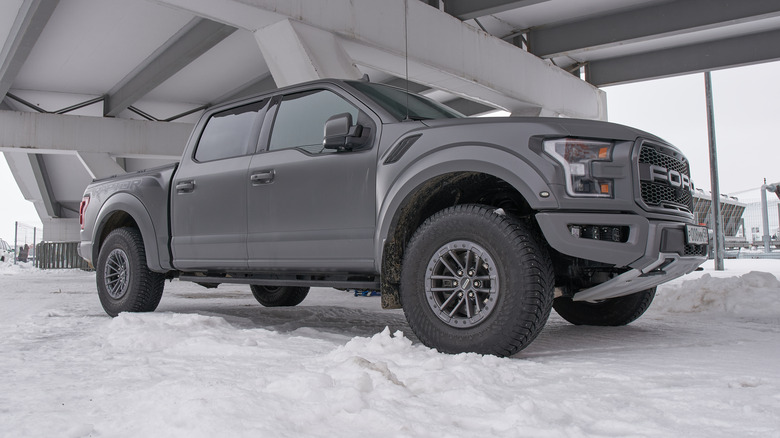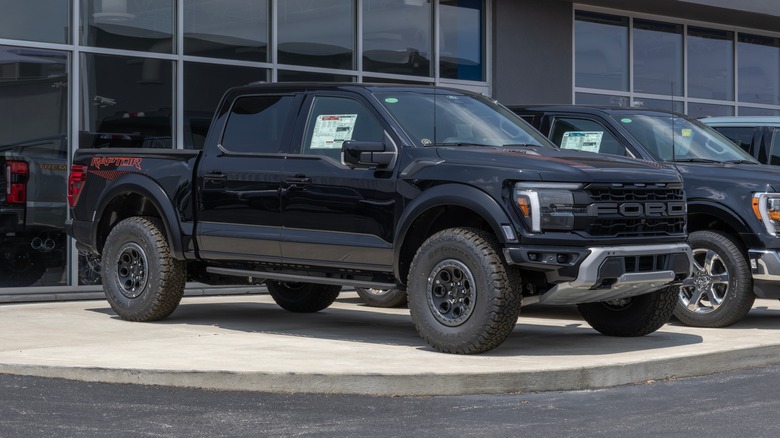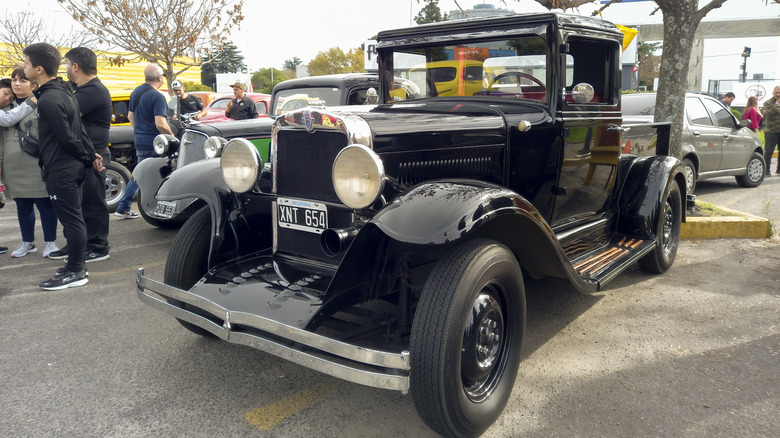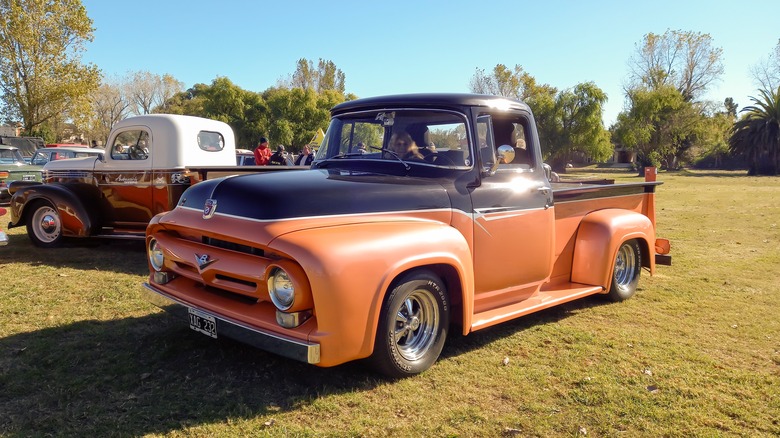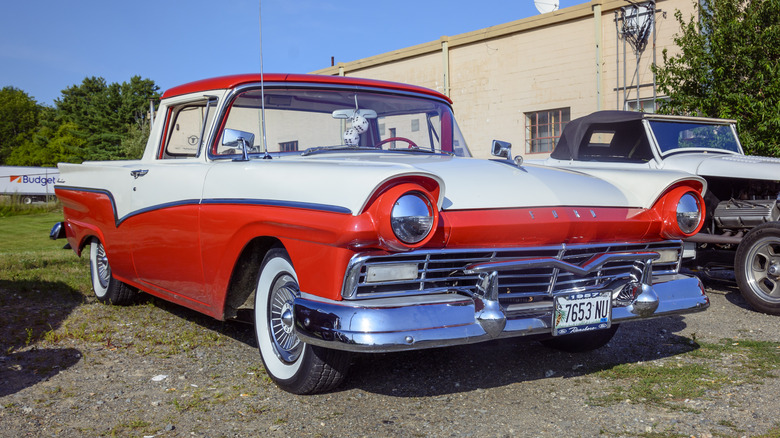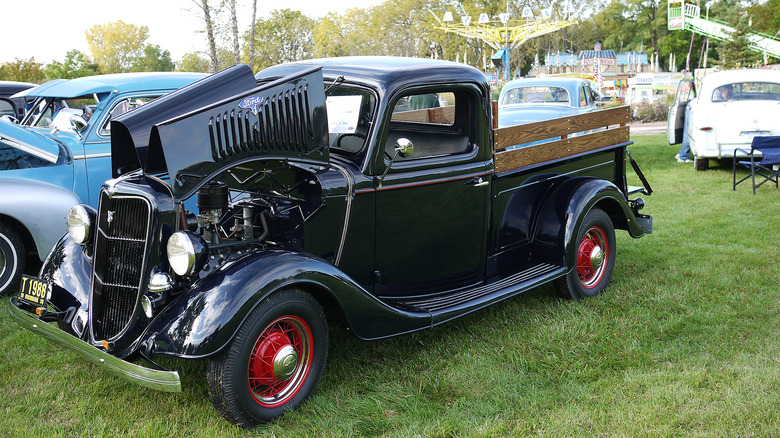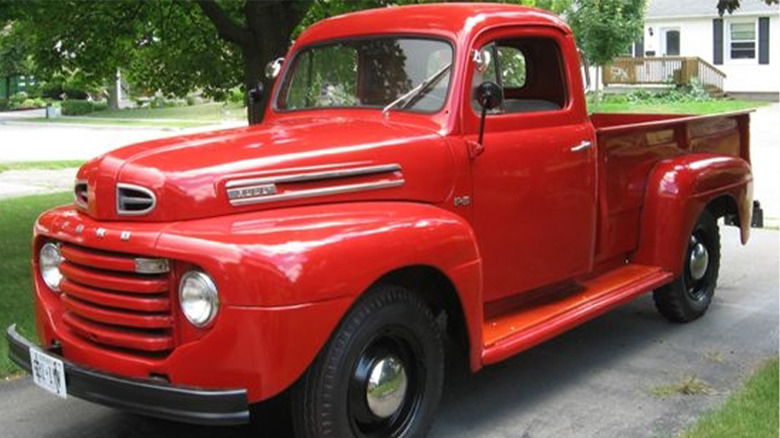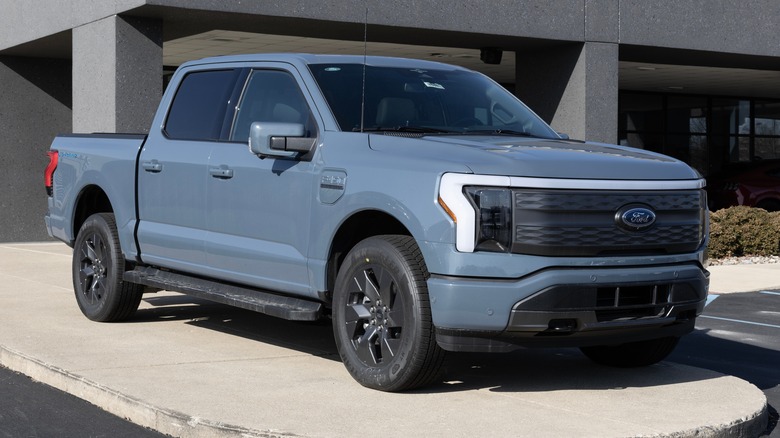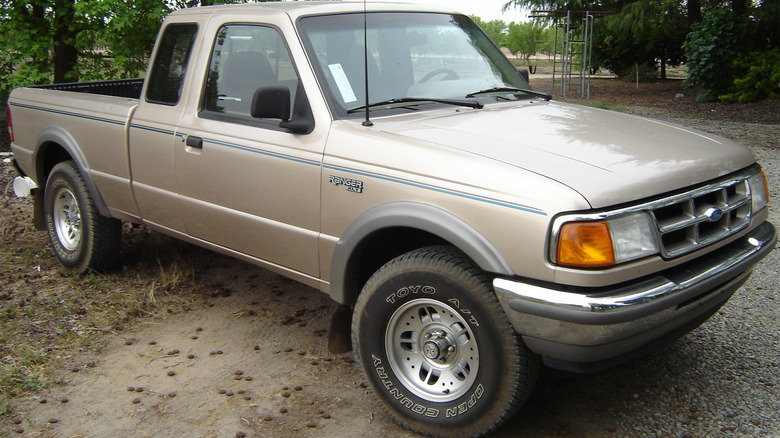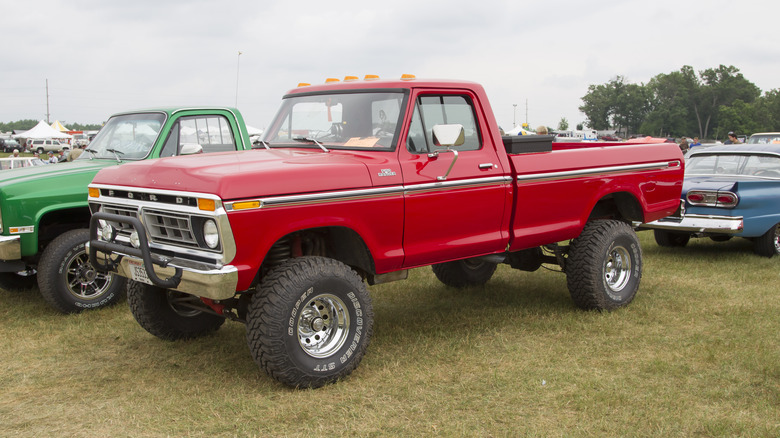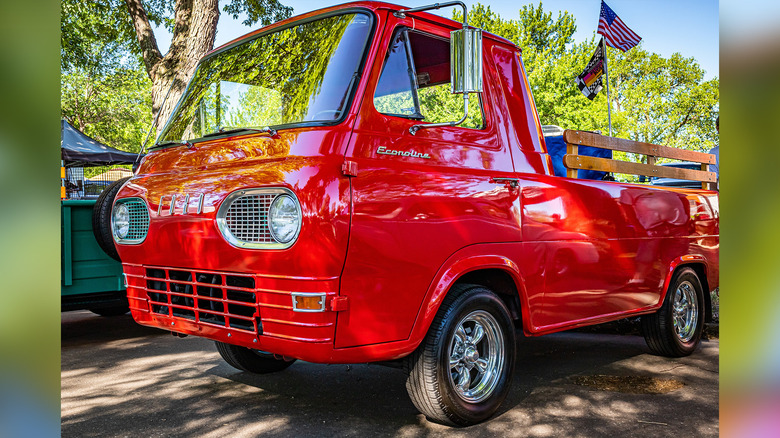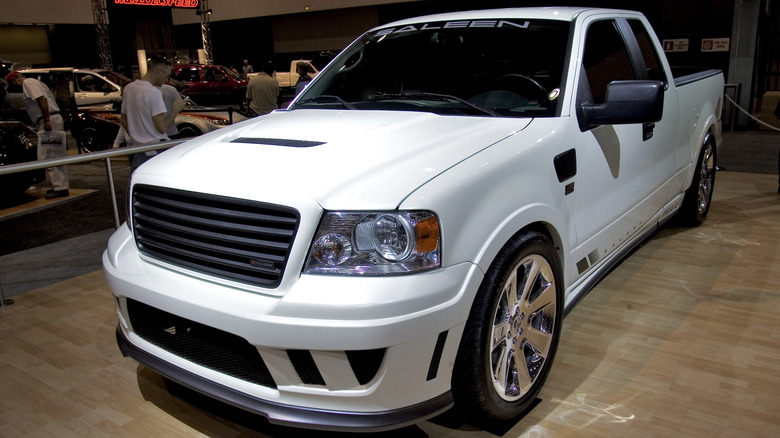12 Of The Best Looking Ford Trucks Ever Designed
When it comes to pickup trucks, there are few names as important as Ford. The company is credited with the first factory-produced pickup truck ever made with the 1925 Model T Roadster with Pickup Body. In the century since then, Ford has released a ton of different trucks from the Ranger to the F-Series and has remained on the forefront of new technology with the Maverick Hybrid and the Ford F-150 Lightning. Ford's long history has also brought with it market dominance — the F-150 has been the highest selling individual truck for over 40 years.
So, given all that, it should be no surprise that Ford has rolled some bangers off of the factory floor. There are so many interesting and unique trucks in Ford's lineup that we could've doubled this list, pulling in the Ford Free Wheelin' truck models, the Ford Bigfood Cruiser, classics like the Model AA truck, and the 1998 F-150 NASCAR edition. However, while those are certainly unique from a rarity standpoint, there are plenty of other sweet-looking trucks. Almost all of these trucks can put in the work too — a few of them made history for being among the most capable trucks of their era. So, in a mix of form and function, here are some of the coolest looking Ford trucks ever built.
2024 Ford F-150 Raptor
Ford hasn't lost its touch after all these decades of building trucks. The 2024 Ford Raptor has an aggressive stance, with larger tires and a massive Ford logo across the front. Ford's Raptor looks like it's supposed to be driven exactly as Ford wants you to drive it, which is however you want. In our first drive of the F-150 Raptor, we were really impressed with its off- and on-road performance. However, the truck is still more than capable and refined enough to be used as a truck and a daily driver if need be.
Under the hood looks as good as rest of the truck. You can get one of these monsters with a 3.5-liter twin-turbo V6 that outputs 450 hp or the same supercharged 5.2-liter V8 Ford puts in the Shelby GT500 that outputs an insane 720 hp. With the upgraded engine, the truck can scoot from zero to 60 mph in a little under four seconds. In short, this truck has everything including both looks and functionality as the truck can tow upward of 8,200 pounds.
The only real downside to this truck is the price. With the V8 engine, prices can easily go above the $100,000 mark. It's also a hulking behemoth of a truck, so if you ever pick one up, you may want to start parking in the back of parking lots.
1929-31 Ford Model A Pickup
The 1929-31 Ford Model A Pickup is one of the most iconic trucks of all time. It replaced the Model T Pickup in Ford's lineup and was one of the first manufactured pickup trucks. We like this truck because it looks like something you'd see in a history book or in a period film. You have the swooping body lines, round headlights, and on some models the bed even had wood trim. It was also one of the first trucks designed after the look of a car. In short, it looks great.
Ford also had the Model A car, and the two models were hits when they first launched. According to Ford, millions of people gathered to see the car, prompting a police response to deal with the excess traffic. Powering the truck was a 200 cubic inch four-cylinder engine that made about 40 hp and 128 lb-ft of torque. Tow ratings didn't exist back then, and there are examples out there of people using the truck to tow lighter items. It was highly functional for its era, though, and it still looks great.
These days, virtually all Ford Model A Pickups are restoration jobs, so few have all original parts. However, there are some out there with less than 1,000 miles, making them almost like new despite being over 90 years old.
1953-56 Ford F-100
We'll talk more about the first-generation F-Series trucks later, but for now, let's focus on the second-generation Ford F-100. For starters, just look at this thing. The exaggerated body lines, unique-looking grill, and puffy overall shape gives this car a classic but also charming look. It was a change in direction for Ford truck design as the brand was looking to make a softer, more appealing-looking truck than the prior generation, which still looked great in its own right.
The truck was — and still is — so popular that there is a yearly Grand National F-100 Reunion event that is held in Tennessee specifically for Ford F-100 enthusiasts. It exists for good reason too. If you opt for bone stock specs, you'll get a wide range of engine choices ranging from a 101 horsepower, 215-cubic inch straight-six engine all the way up to the 272 cubic inch V8 that produced 173 horsepower. Enthusiasts have also put race engines in these trucks, with one builder putting a 427 cubic inch Ford crate engine that is advertised as having 535 hp.
In other words, whether you prefer the purist viewpoint of keeping the truck stock or you want to turn it into a racer, it doesn't matter. The F-100 can do it.
1957-59 Ford Ranchero
In the years just before the American muscle car era took off, automakers were trying to figure out a way to make a truck that also looked like a car. Chevy had the El Camino, but Ford really hit the mark with the first generation of the Ranchero. Its strong body lines were par for the course in the 1950s and its long body and fins made it look like something that rolled off of Cadillac's factory floor. We mean all of this in a good way. This car's design was amazing.
As the story goes, Ford had customers in Australia who wanted a truck to take their products to market during the week, but was still nice enough to take to church on Sunday. Ford built such a truck in the 1930s and kept it down under until the late 1950s, when the company started selling it in the U.S. as the Ford Ranchero. The first-generation model was a Ford Courier station wagon with a truck bed instead of a backseat. The next generation would use the Ford Falcon as its base.
The model competed directly with Chevy for years until the automaker discontinued the El Camino — at least, initially: The El Camino actually lasted into the '80s in one form or another, while Ford discontinued the Ranchero by the late 1970s. Regardless, that first-generation was really something special.
1935-41 Ford Model 50 Pickup
We return to the 1930s for our next selection, the unique Ford Model 50 half-ton pickup. It wasn't too different from the Model A Pickup listed earlier, but this model featured more refinement. Gone were the straight lines that made it look boxy and the replacement was a curvier cab that better accentuated the fender curves. Much like the Model A Pickup, this variant also commonly had wood integrated into the design. Ford changed quite a few things, though.
Since Ford was making car bodies out of steel at this point, it allowed for several of the design elements like the aforementioned curvier cab along with the heart-shaped radiator grill. Ford also added things like a longer bed. The engine was far more capable as well, more than doubling output to 86 hp and increasing the torque to 144 lb-ft. Ford was able to do this because the Ford Model 50 Pickup was Ford's first V8 truck.
The Ford Model 50 Pickup had a few other distinctions as well. Ford produced the truck until the beginning of World War II when all automakers ceased production of passenger cars to assist in the war efforts. After the war, Ford would release the first F-series truck, leaving the Model-style pickups of yesteryear behind.
[Featured image by F. D. Richards via Wikimedia Commons | Cropped and scaled | CC BY-SA 2.0]
1948-52 Ford F-Series
Ford came out swinging after the war was over. The company didn't know it at the time, but the Ford F-Series would go on to be Ford's most successful product. Its first F-Series truck was a real looker as well. It kept some of the Model 50 pickup's curve, but modernized the rest of the body. Gone were the sweeping fender lines, in favor of a beefier fender that matched the simpler grill design.
Ford's previous truck efforts were aimed at commercial customers and farmers. For the F-Series, Ford wanted to sell the truck to everyday people. With the war over and the economy booming, the U.S. was in need of trucks in residential driveways and that's what the F-Series aimed to accomplish. Ford did some small things like making the truck a few inches wider and a bit taller to provide more comfort and headroom. The doors were also moved forward on the chassis slightly to make it easier to get in and out.
Not only did these design changes help introduce new pickup truck owners, but it also changed how Ford made trucks. It was the first pickup model from Ford with a truck-specific chassis designed for this use case.
2024 Ford F-150 Lightning
The Ford F-150 Lightning is Ford's big entrant into the EV wars, competing against the Tesla Cybertruck and the Rivian R1T. Ford's offering looks the part, with a nice full-length light bar on the front, but also a faux grill to help the Lightning look like a typical truck in Ford's lineup. At the time of its release, other EV trucks had unique designs that made them look more like EVs. We appreciate that the Lightning looks a little more normal. And it's just as capable under the hood.
The EV is equipped with electric motors that output either 452 or 580 hp and 775 lb-ft of torque. That power allows the Lightning to tow up to 10,000 pounds, which is excellent for an electric vehicle even though its range goes down when towing something that heavy. It's even quicker than the Ford Raptor we talked about earlier, so the truck is good at just about everything, except off-roading as it's not quite equipped for that.
The F-150 Lightning also comes equipped some neat extra features. For example, in the absence of a traditional internal combustion engine, the truck has a massive frunk for extra storage. We do quite enjoy good form, but it's even better paired with good function too.
1993-97 Ford Ranger
The second-generation Ford Ranger was just a footnote in Ford's extensive truck history, but it was quite an attractive model for its era. It's a smaller truck, with a 107.9-inch wheelbase for the regular cab model and 125.2 inches for the crew cab. For comparison, the Ford F-150's wheelbase could get up to 155 inches. Thus, the Ranger was a nice truck for getting around town and carrying the occasional load in the back. This wasn't a truck meant for towing or heavy work.
Ford kept it simple with the second-generation Ranger. The body was slightly curvy, and the grill had a grid design. There was virtually nothing ostentatious about this truck and that unassuming nature helped it blend into the crowd. They came in a variety of configurations including three cab choices and three engine options that produced anywhere from 80 to 160 hp and from 133 to 225 lb-ft of torque.
With its average engine options and unassuming design, you would think that would turn shoppers off. The opposite happened instead. Ford sold a ton of these trucks and many are still on the road today.
1973-79 Ford F-150
Ford had already hit its stride with the F-150 by the time the '70s rolled around, so it's no surprise that the sixth generation Ford F-150 was a classic. Ford made the truck from 1973 through 1979, giving us six good years of the F-150. By this point, Ford had brought boxy looks back to its truck lineup, so the F-150 feels like it has a bit more in common with some of Ford's first trucks as opposed to the curvier ones that came later. However, Ford added just enough curve to the various body lines to give the truck a pleasing overall design that didn't go too far in either direction.
The 1970s Ford F-150 was unique in other ways. Ford offered a number of unique looks for this truck, ranging from solid colors to the multi-tone paint jobs of the Free Wheelin' models. In addition to the outside customization, the truck had a few different engine options. Unfortunately, it came during an era where the U.S. government had cracked down on emissions, so engines weren't as powerful in the '70s as they were in the '60s, but the F-150 still did just fine.
Ford did a great job giving the F-150 of the 1970s a timeless look. If you bought one and fixed it up, it doesn't look like a 50-year-old truck.
1961 Ford Econoline E100 Pickup
The 1961 Ford Econoline E100 Pickup is easily Ford's most unique-looking truck. Looking at it immediately evokes memories of the Honda Acty. But the thing is, the Honda Acty didn't come around until 1977, so Ford gets the win for coming up with this design first. It also shares some similarities with the Ford Ranchero from just a few years before. Previously, Ford chopped the back end off of a station wagon to make the Ranchero. The Econoline E100 Pickup is simply an Econoline van that got the same treatment.
This little thing just looks cool. It looks like something you'd see at a large event like a concert or a festival, a vehicle purpose built for a specific task that you wouldn't typically see on the open road. However, that's exactly where this E100 Pickup went. Ford found inspiration from the Volkswagen Bus, and you can see the similarities in the flat nose and rotund appearance.
Upon first glance, you might think the truck would flip over during a panic stop, and you wouldn't be wrong. In initial testing, Ford found that the truck's back wheels easily left the pavement during panic stops. To put a stop to that, Ford installed a 165-pound weight under the back end of the truck under the bed.
2007 Saleen S331 Sport Truck
When you imagine a car getting a special version, you probably normally think of the classic fast muscle cars of the 1960s like the Shelby Cobra or the Shelby Mustang. However, a couple of Ford's trucks got a similar treatment. The 2007 Saleen S331 Power Truck is essentially a souped-up Ford F-150. Saleen modified the truck to make it sleeker, faster, and cooler looking. We think it worked. The 2000s wasn't the most memorable era for vehicle design, so we applaud any attempt to make a car from that time look better.
Saleen put several modifications on the F-150, including new bumper covers, a blacked-out grill, a vented hood, fender vents, side skirts, a unique tailgate trim, larger rims, and side-exit exhaust pipes. The result is a truck that sits lower to the ground, looks meaner, and definitely sets itself apart from other 2007 Ford F-150s out there. Saleen also switched out some of the interior materials. In terms of performance, these trucks maxed out at 450 hp thanks to the inclusion of a supercharger on top of the 5.4-liter V8. Overall, the truck weighs 5,400 pounds.
Technically speaking, Ford didn't make this truck all the way through. Saleen is its own manufacturer and has to get approvals and such like Ford, GM, or any other automaker. However, it did use the Ford F-150 as a base and that counts. This is easily one of the best-looking Ford F-150 of the 2000s.
1991 Ford Ranger Skyranger
Last up is one of the most unique and rare Ford trucks ever made. The Ford Skyranger is technically a Ford Ranger from 1991, modified by the American Sunroof Company (ASC) to become a convertible. This truck was made during one of many creative eras for Ford and the company wanted to see if a convertible truck would do well. We'll never know for sure because Ford only commissioned between 17 and 19 of these things, depending on who you ask.
That means this gem is as rare as it is beautiful. The design keeps the pleasing aesthetic of the 1990s Ford Ranger, while incorporating aspects of a soft-top convertible. You can find brochures on eBay and other places with pictures showing how ACS converted the Ford Ranger into a convertible. In the rare instances where the Skyranger goes on sale from a private buyer to the public, it usually also comes with a black tonneau cover, which gives the entire truck a gorgeous two-tone look. They all also have decals on the side letting folks know that it's a Skyranger.
These are super rare cars but there is at least one in Austin, Texas, which is often spotted and photographed to be shown off on Reddit. Still, if you ever get to see one of these, it truly is one of Ford's most interesting trucks.
